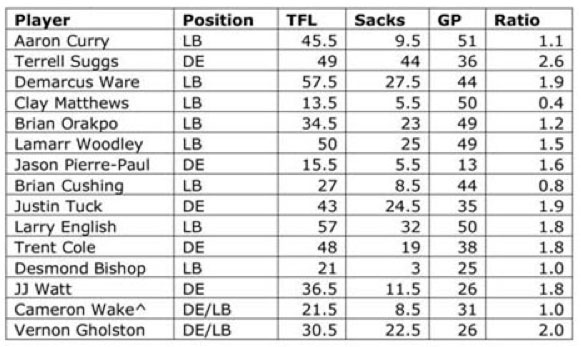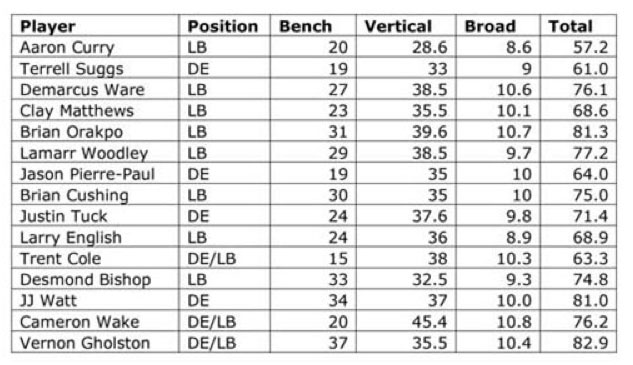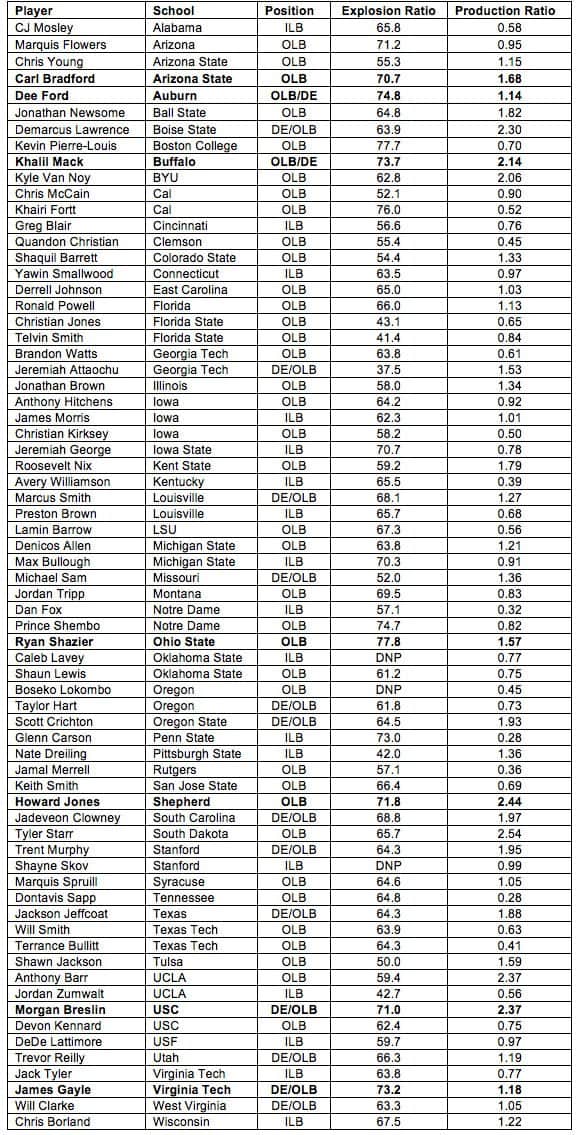2014 Rookie Linebacker Ratios

When trying to determine who the next breakout rookie is or who to target in rookie drafts, fantasy owners often rely on one of two bases – quantitative/statistics or qualitative/scouting. I happen to believe both are essential. Focusing on one factor often results in oversights and missed opportunities. Each year I look into two ratios used by several NFL front offices to assess whether defensive lineman and linebackers have the ability to succeed in the NFL. I do this for two reasons – I want to identify/affirm my sleepers and I also want to assess whether I am off on any of my initial qualitative rankings.
Here I’ll focus on the linebacker results.
Ratio Background
In Take Your Eye Off the Ball, Pat Kirwan explains two statistics used to determine if a front-seven defensive player is a playmaker or explosive enough to succeed at the professional level. These calculations are based on college production and NFL Combine/Pro Day results. They are called the “explosion number” and the “productivity ratio.”
The explosion number is calculated as “Bench Press Reps + Vertical Jump + Broad Jump.”
A player with a total of 70 plus garners attention since he possesses the explosiveness to win battles at the line of scrimmage. The explosion number isn’t the only condition to consider. Some players have posted an explosion factor below 70 and gone on to become a Pro Bowler. Terrell Suggs is a perfect example. That success despite the low number is explained by Kirwan’s productivity ratio. This is calculated as “Sacks + Tackles for Loss or “TFL” / Number of Games Played.” This ratio shows how often a defender plays behind the line of scrimmage and exemplifies playmaker tendencies. The targets here are players with ratios greater than 1.0.
I acknowledge there is no certainty with these ratios. Like anything, if a player hits one, both, or none, there are no guarantees. However, as you will see in the historical ratios below, frequently individuals who breach the target explosion and productivity ratios have successful careers. There are instances like Vernon Gholston who appear to be a sure-fire stud based on these numbers, but there are always exceptions. These ratios are not to be considered the only data point, but one of the many to analyze in ranking rookie IDPs.
[am4show have=’p2;p3;p4;p5;p6;’ guest_error=’sub_message’ user_error=’sub_message’ ]
Historical Ratios
The following includes a number players drafted who appear to be busts after being selected early in the NFL draft or who have performed extremely well:
Productivity Number

Explosion Number

Summary Findings
- Several players like DeMarcus Ware, Justin Tuck, Lamarr Woodley, JJ Watt and Brian Orakpo performed well in both instances and all have had or have started successful NFL careers.
- Desmond Bishop was not drafted until the sixth round in the 2007 draft, but he breached both ratios. He went on to become a top five dynasty linebacker for a period of time.
- Cameron Wake, who played in the Canadian Football League before making it to the NFL, also produced solid ratios.
- Vernon Gholston is a clear bust despite having some of the highest ratios in both instances.
- Players like Jason Pierre-Paul, Terrell Suggs and Trent Cole (who are dominant defensive ends) hit the target in the productivity ratio, but did not work out well, which is evident in their low explosion numbers.
- Inside linebackers (many who are not even included here intentionally like James Laurinaitis) may not hit these thresholds because of their style of play. These ratios seem to gloss over that aspect of the front seven and must be considered when assessing and ranking rookies.
The most important result from the above is that the players who reach the target ratios in both cases appear to have a greater chance at a success. As a result, that will be the target in assessing the 2014 draft class linebackers to better focus on potential sleepers and draft targets below.
Backtesting 2013 & 2012
Before jumping into the 2014 prospects, let’s take a look back at the draft class results from the last two years, see who was tagged as linebackers who hit both ratios, and analyze the accuracy:
Luke Kuechly, MLB CAR
Kuechly performed quite well in his rookie year and finished among the top five to ten IDP linebackers in 2012 and 2013. He’s now considered a top five dynasty linebacker. This is a solid hit.
Mychal Kendricks, ILB PHI
Kendricks started in each of the Eagles’ games in 2012 at the strong side linebacker position. For IDP purposes, he finished in the top 60 among linebackers. That’s largely due to the position that he played and the limited tackle opportunities he was presented with on the strongside. In 2013, Kendricks started in the middle of the Eagles’ new 3-4 base scheme. He was an every down linebacker and finished as a top 25 linebacker. This is also a hit.
Miles Burris, WLB OAK
Burris was often undrafted in 2012 rookie drafts or left until the later rounds. However, he ended up starting for the Raiders from week six through the end of the 2012 season at weakside linebacker. He finished in the top 45 linebackers over that period. Given he was an afterthought and ended up starting through the end of the season and produced, he was a hit in his rookie year. However, in his second year, he fell off the map after starting the year on the PUP list. I’d still consider him a hit given the rookie season, but it looks like he’s destined for a reserve role in 2014. A year ago, I would have considered this a hit, but the injury stalled his progression and it’s migrating to a miss, but we need another healthy season to assess.
Nick Perry, OLB GB
He hasn’t put up great numbers to date and has struggled in the transition from college defensive end to outside linebacker with the Packers. Despite that, it sounds like the Packers are going to use him in an elephant-type role in 2014. This one isn’t a fail yet, but things aren’t looking great given he has six career sacks in only two seasons. While he’s struggled, he continues to accumulate quarterback pressures and injuries have been a consistent thread throughout his NFL career to date. Perry’s still a TBD, but in a new 2014 role, this should be the deciding year.
Melvin Ingram, OLB SD
Ingram played sparingly in his rookie year and then tore his ACL in OTAs in 2013. There’s not much success to note yet, but he’s projected to start again in 2014. He’s a viable option in big play leagues. We’ll wait on Ingram until he has meaningful snaps under his belt.
James-Michael Johnson, ILB CLE/KC
Ouch. Big time miss! He does have the opportunity to win an inside linebacker job in Kansas City this year, but things aren’t looking positive. This is a miss.
Sio Moore, SLB OAK
Moore ended up starting 11 games as a rookie for the Raiders at the strongside linebacker spot. Unfortunately, the spot hasn’t been conducive to fantasy production, but he’s seeing snaps and producing when called upon. He’s relegated to a two-down role at this point playing 57 % of the team’s snaps in 2013, but he has the potential to play more as he matures. This one is also to be determined and trending up given a solid rookie season.
Jamie Collins, OLB NE
Collins is situated to start in 2014 at the strong side linebacker spot and reports are that he’ll be a three down linebacker over Dont’a Hightower. There’s still some debate on that last fact, but that’s where is seems to be headed. While a small sample, Collins played close to every down in the Patriots’ two playoff games last season and he excelled. Given the small sample size, we can’t conclude on this selection yet, but it’s looking positive. 2014 will also be a big year for Collins given the expanded role.
So, we’re at two hits, five pending, and one miss. We’re still very much up in the air with this, but there are more positive signs than not with the pending cases.
On the flipside, Zach Brown of the Titans missed on both ratios in 2012. He dominated in his rookie year and finished in the top 30 among linebackers in most leagues – this is a prime example of where this quantitative analysis missed. With that said, it appears to have identified some strong candidates as discussed above.
2014 NFL Draft Class – Linebackers
Note: The bolded players below hit the target for both productivity and explosion numbers.
 Khalil Mack, OLB
Khalil Mack, OLB
Mack is a beast and hitting both the explosion and productivity ratios highlights that. His production ratio is off the charts and he’s situated to excel at the next level given his versatility. At Buffalo, he played in a 3-4 scheme and did it all – he blitzed, dropped into coverage and flat out made plays. The only downside to Mack is if he’s drafted as a 3-4 outside linebacker. We need him drafted to a 4-3 defense to contribute solid IDP value.
Anthony Barr, OLB
There are a number of concerns with Barr for IDP purposes. His explosion ratio is atrocious, he’s likely to be drafted as a 3-4 outside linebacker and if he’s not drafted to a 3-4, his next best fit is a strongisde 4-3 outside linebacker. So, unless you’re in a sack-heavy league, Barr is an average rookie option. Even if you’re in a sack-heavy league, Barr’s explosiveness as exhibited is a concern to take note of.
Dee Ford, OLB/DE
He’s an undersized pass-rusher, but so are Von Miller, Robert Mathis and Elvis Dumervil – those are comparisons right out of Ford’s mouth. Regardless of the scheme he’s drafted into, he should wreak havoc at the professional level. He played defensive end throughout his college career, so a 4-3 scheme is a logical fit despite the size concerns. Obviously, if he’s drafted as a 3-4 outside linebacker, his value will take a hit, but if he’s drafted into a 4-3, he possesses tremendous upside.
Carl Bradford, OLB
Another player who hit both targets, Bradford is a tremendously athletic hybrid linebacker who excels in pass-rushing situations. He played both standing up and with his hand in the dirt at Arizona State, but many view him better situated as a linebacker. With the ability to play many of the 4-3 linebacker spots, Bradford will be an intriguing option to see where he lands. If in a 4-3 with the potential to land a middle linebacker spot, he could shoot up draft boards.
Ryan Shazier, OLB
I see someone raving about Shazier every other day on Twitter. People are falling in love with this kid and for good reason. His explosion and production numbers do nothing to dispel that love. Both numbers are well above the target level, which is impression comparatively to the numbers of other prospects historically. Shazier is quick, athletic and covers a ton of ground. He’s probably a better fit for a 4-3, but it’s also possible a 3-4 scheme team drafts him and sticks him inside. He’s a player to keep an eye on given his athleticism, speed, production and the ratios above and he should land in a positive IDP situation given his positional fit.
Telvin Smith, OLB
Some draftniks are all over Smith, but both his explosion and productivity ratios are lacking. He possesses the speed as exhibited at the Combine, but given the lack of production and the explosion numbers above, he’s someone who will carry a red flag for me unless he lands in a perfect opportunity come draft day.
Howard Jones, OLB
He played Division II football, but his numbers warrant a closer look. He’s projected to be drafted in day three, but keep an eye on where this kid is drafted given that he hit both ratios. Many believe he’s a developmental prospect, so remember the name when thinking about later round picks or stash options a month or so from now.
Morgan Breslin, DE/OLB
A potential day three pick, Breslin is worth a look in IDP leagues given the pass rushing ability he exhibited in 2012 (he was injured much of 2013). Breslin is likely better situated to play outside linebacker in a 3-4 scheme, so his IDP upside will be limited, but he’s worth a look given his explosiveness and historical production. The best case scenario is that he’s a stash candidate given where he’s expected to be drafted.
CJ Mosley / Chris Borland, ILB
As noted in the introduction, don’t be concerned with the fact these two players didn’t hit their ratios. If an inside/middle linebacker hits, it’s an extremely positive sign (see Luke Kuechly), while if they miss it’s not a big deal. Both are very safe options who should remain atop IDP rookie rankings.
Jadeveon Clowney, DE/OLB
Maybe this is a sign of how much he cares, but surprisingly, Clowney’s explosion number is off the mark. Not only that, but he clearly toned down his play in 2013 to ensure he didn’t get injured. The difference between his 2013 and 2012 numbers are staggering. Above all, what’s most surprising with Clowney is how low his vertical was.
Forget the vertical for a minute, one of the biggest issues with Clowney is that the Texans are lined up to draft him and slide him into IDP purgatory as a 3-4 outside linebacker spot – that would be a huge hit to his IDP value. It’s crazy how much things have changed in only a few years as he’s no longer considered the slam dunk prospect everyone once viewed him as. Many IDP vets even claimed he’d go top five in rookie drafts.
Not any longer.
Summary
While these numbers are not definitive in the determination of NFL success and fantasy greatness, they serve as additional data points to consider in drafting and ranking rookies. While this analysis isn’t fool proof, it singles out several players as targets to consider earlier than most owners would for a justifiable reason.
Follow Steve on Twitter @SteveWyremski
[/am4show]


































































